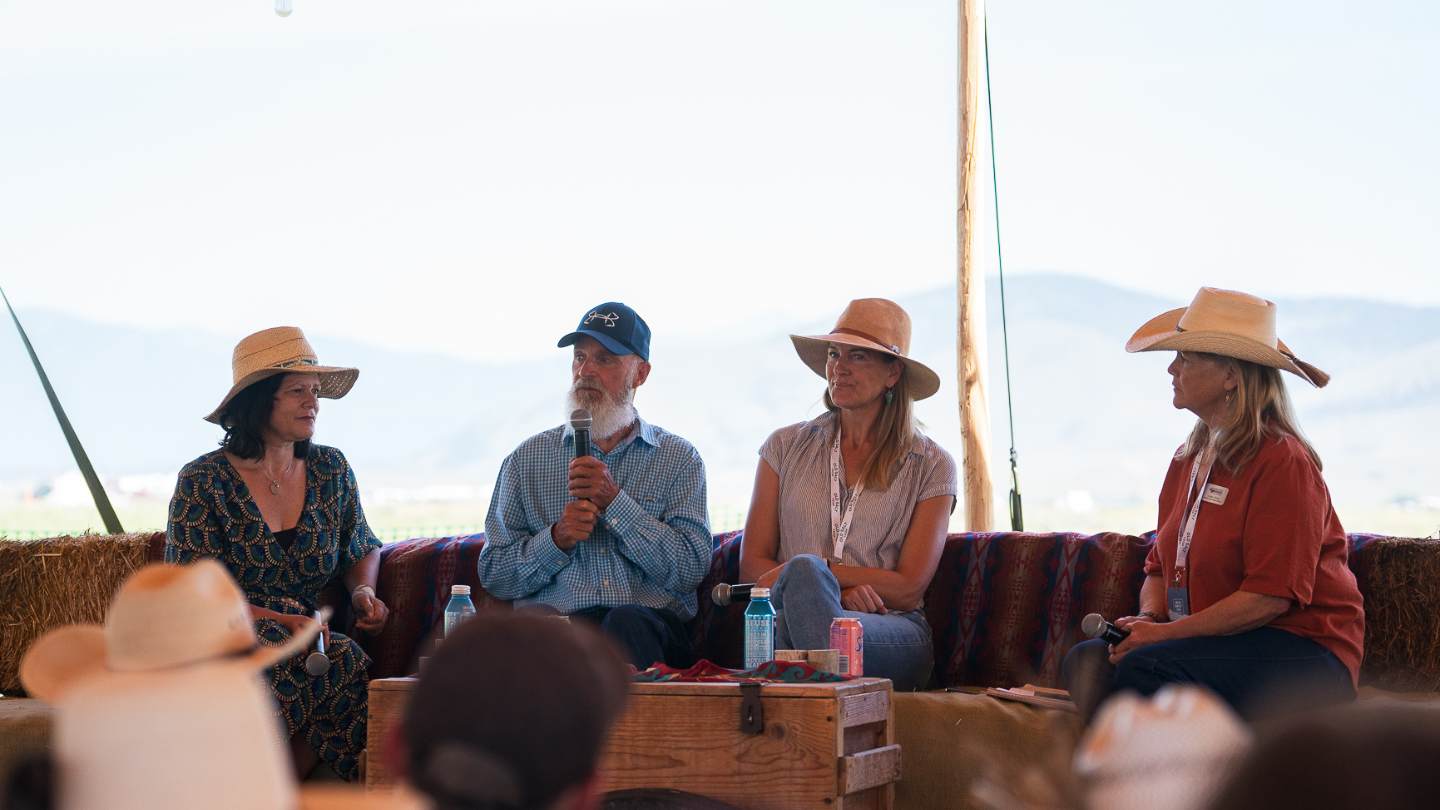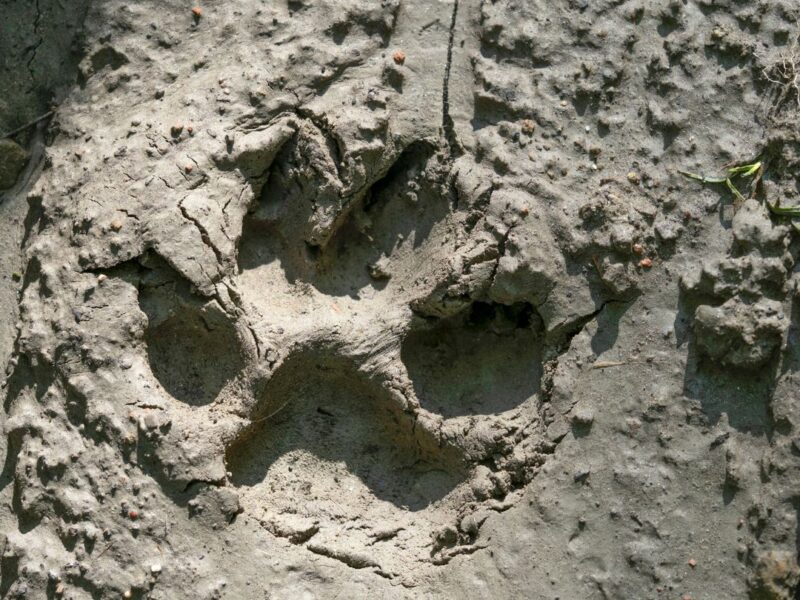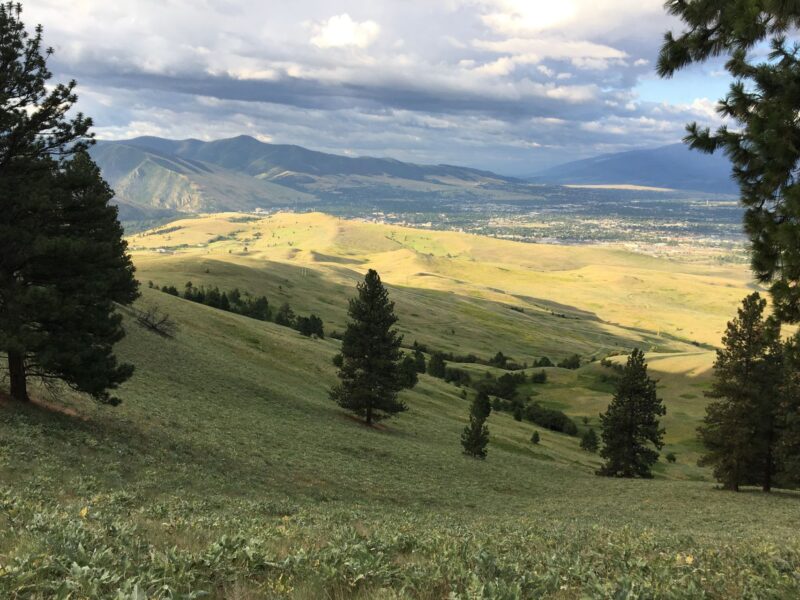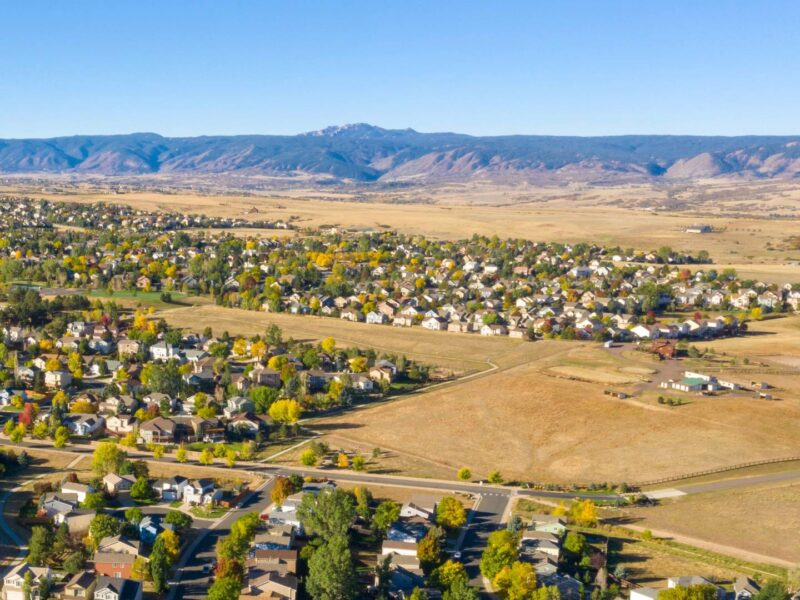We’re inside and it’s holding us: Fred Provenza, Nicole Masters and Kate Geagan
Nutrient cycles for people and planet, at the Old Salt Festival.
In June, the second annual Old Salt Festival brought over 2,000 people to Helmville, Montana, for a rocking celebration of land stewardship through food and music, community and dialog. Old Salt Co-op, host of the event, calls the way its member ranches practice animal agriculture “nourishing food while maintaining and improving long term ecological health, leaving space for the wildlife that share the landscape.”
Among many enticing offerings at Old Salt was a lively panel discussion on how land stewardship influences food quality, human health and rural resilience. The event brought together for the first time thought leaders Dr. Fred Provenza (professor emeritus of Animal Science at Utah State University, and prolific author, most recently of Nourishment: What Animals Can Teach Us About Rediscovering our Nutritional Wisdom, 2018), Nicole Masters (agroecologist and author of For the Love of Soil: Strategies to Regenerate our Food Production Systems, 2019) and Kate Geagan (director of strategy for FoodAndPlanet.org, dietician and author of Go Green Get Lean: Trim Your Waistline with the Ultimate Low-Carbon Footprint Diet, 2009). With moderator Linda Poole of WLA, the panel addressed the powerful “why”, and complex “how”, of raising nutrient dense foods on whole and healthy working lands. Snippets of the conversation follow.
NICOLE: As we walk the land, know that land keeps the history of activity that’s been happening for thousands of years. Enter onto a piece of land and be grateful to be part of this story, because microbiology knows that we’re here. You step into the field and the microbes are like, “Oh, it’s Fred. Yeah. Cool.” And microbes and fungi throw up their spores looking for the carbon that comes off Fred.
These microbes communicate in incredible ways! They communicate to plants and to this whole landscape in ways that we’re deaf, blind and dumb to. Right now, underneath your feet is a city. There are bacteria that make fine crumbs, and fungi that make large aggregates. They’re weaving a message right through this entire landscape, signaling to each other using different types of volatile organic compounds. Every single cell has 100,000 receptors that are waiting for a signal. Key question: are you giving them a signal for more vibrancy in life, or are you giving them a signal for degradation and loss?
These microbes also are transported up into the atmosphere and can change climate dynamics. Yes, we alter climate through our land management practices. Poor management reduces rainfall in Montana by 20% and it’s microbiology, it’s ground cover, it’s the volatile organic compounds, it’s plants. Thinking in whole systems is key, and microbiology is a huge part of this.
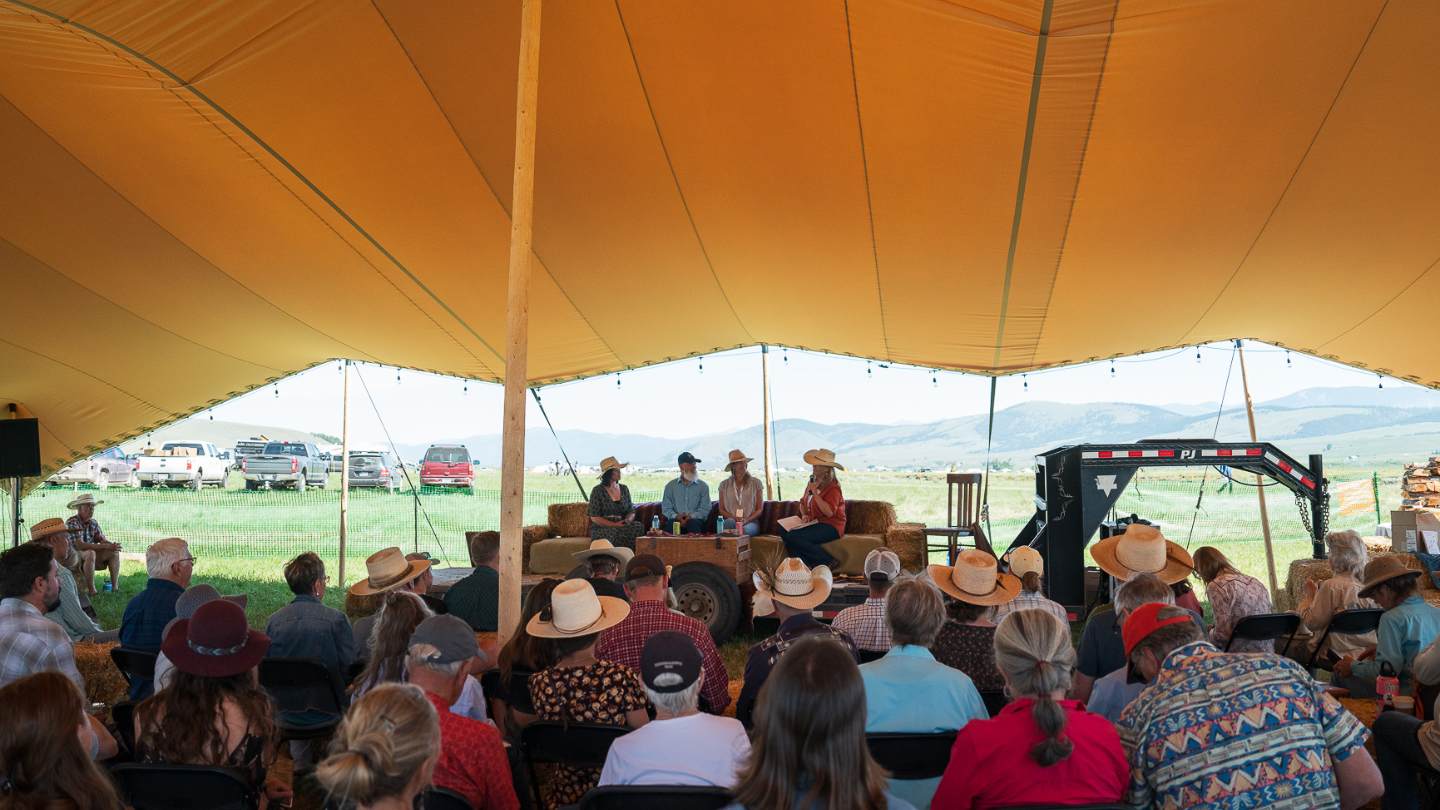
The microbial diversity of your gut directly relates to your health. And it starts on the land, how we treat our microbes, which translates into nutrition because animals are what they eat.
– Kate Geagan
FRED: Plants can transform dirt into soil that favors diverse mixtures of plants that create homes, grocery stores and pharmacies that support literally all life, below and above ground. Each plant has this unique rhizosphere that nurtures all different kinds of organisms, and the multitude of those creates so much life.
When a cow, sheep, deer or whatever eats a diverse array of plants, those phytochemicals are getting into the body. They get into the capillaries, and cells can only forage on what’s in the capillaries. Only if you have this diverse mixture of health promoting compounds, each cell can take what it needs.
KATE: Food is more than just the nutrients. It’s information that tells your cells how to behave. So in this complex dance of up-regulating human genetic expression, the question is “What’s in your microbiome?”
The microbial diversity of your gut directly relates to your health. And it starts on the land, how we treat our microbes, which translates into nutrition because animals are what they eat. As you go up the food chain, you get bioaccumulation both in the positive of nutrient density or in the negative. Only when the land is flourishing and the animals we are raising and those communities are flourishing, do we get human flourishing.
LINDA: As ranchers raising food, we’re also stewards of land, water, wildlife, communities, and of our shared future. While we’re thinking about balancing wacky weather, water scarcity, human health and economics, what would you three like us to have in mind about the relationships between our actions and what we want to create in the world?
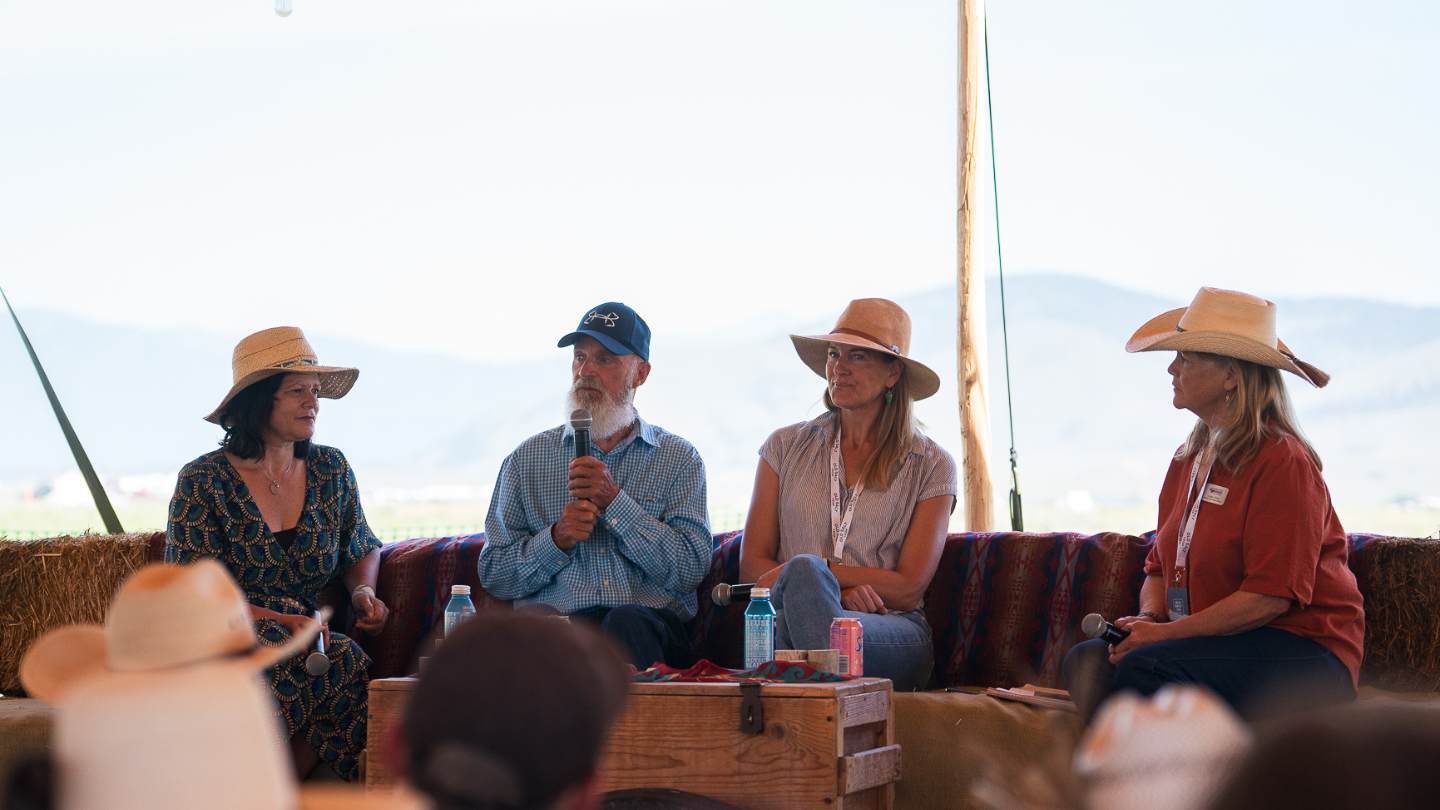
We’re members of nature’s communities, right? What we do to them, ultimately we do to ourselves. We nurture them and they nourish us.
– Fred Provenza
FRED: We’re members of nature’s communities, right? What we do to them, ultimately we do to ourselves. We nurture them and they nourish us. So we create intimate relationships with the landscapes we inhabit – with water, with soil, with plants, and with the people and all the creatures on those landscapes.
I think a lot about the power of community to enable health from the ground up. We focus on food and that’s important but it’s incredible to realize the power of community itself, of love and compassion for one another, from the children through the parents, through extended families and through communities. That’s huge in terms of health, every bit as important as anything else.
NICOLE: We can’t have regenerative agriculture without regenerative economics. I think communities like this can unlock how we work going forward so that dollars stay in the community and so producers are more accurately compensated for the value that they are bringing. Too much of the value currently is extracted from the investor side when all of the important value, and frankly the risk, is on the producer side.
I think it’s a really exciting time to be on the planet because what we’re witnessing is the emergence of a new paradigm. This is as revolutionary as discovering that the planet was round. Suddenly things are shifting and we’re designing something that’s regenerative from within a degenerative system right now. Instead of coming from extractive – how do I control it, how do I make it fit to me – instead we ask, how do I fit to the world? And suddenly everything shows up differently. What action am I taking today that brings more vibrant life? How is this land something that I can be complementary to? So we’re not a steward that’s on the outside holding it, we’re inside and it’s holding us. That’s a very different way of operating, and then what I start to see happen is life. Extraordinary life.
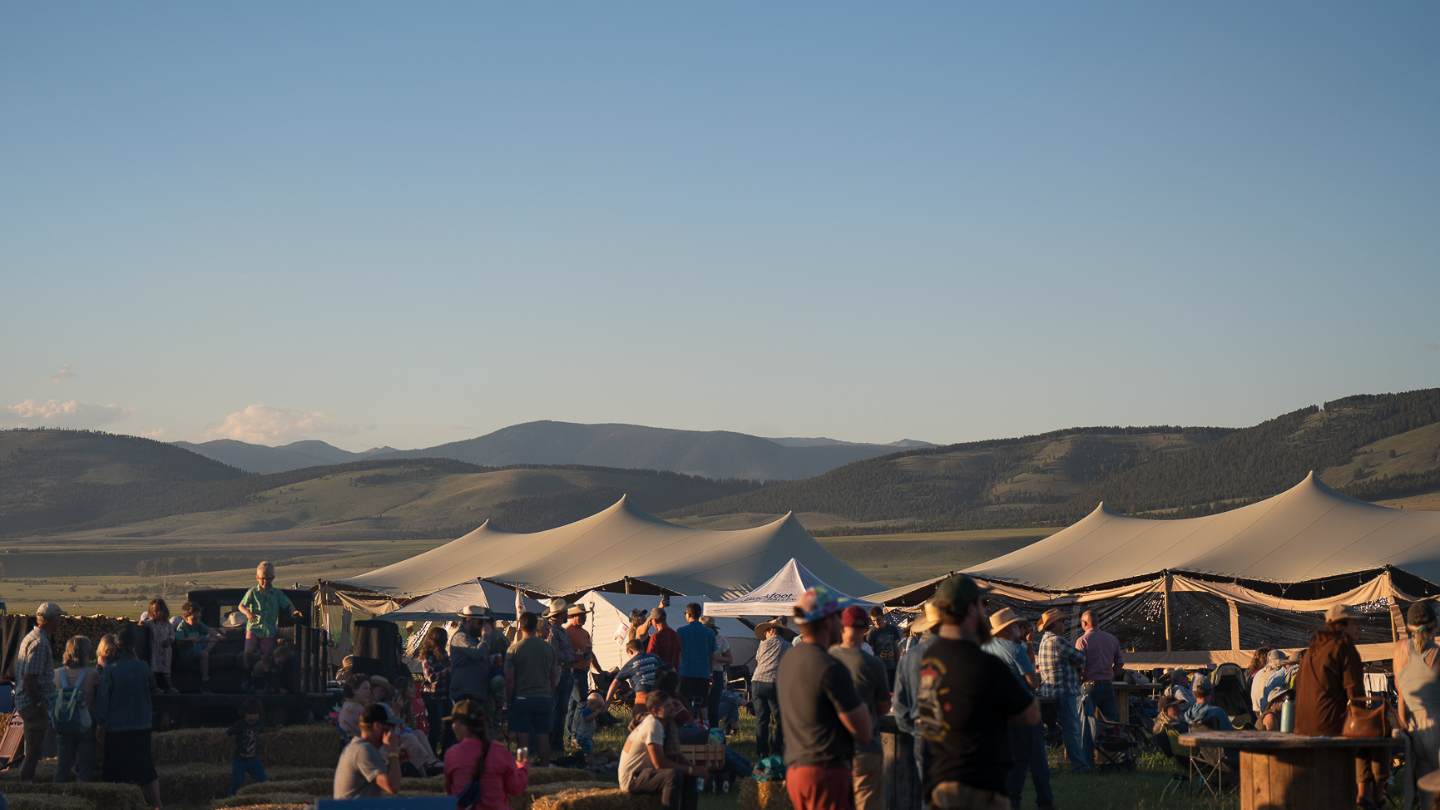
I think what we have valued in ranching communities and farming communities is resistance, is strength, is what we call in New Zealand the stiff upper lip. … Resilience is a different thing. Where does that resilience come from? It comes from being in communication. It comes from community and sharing.
– Nicole Masters
KATE: There’s a real connection between resilience in an ecosystem and resilience in a human body. Resilience equates to whether you’re able mentally, physically, spiritually to take a hit, and then bounce back. For humans to bounce back, to really flourish, takes a healthy diet with lots of diversity, with food produced in organic, regenerative ways that work with the land and ecosystems and the producers. That creates huge biologic resilience so we’re more able to not only sidestep a lot of the chronic health conditions that plague America, but to actually thrive.
NICOLE: I think what we have valued in ranching communities and farming communities is resistance, is strength, is what we call in New Zealand the stiff upper lip. We don’t share emotions, we’re very strong, but the problem with being strong and resistant is that at some point you break. And what we’re seeing is breaking happening in the ranching community.
Resilience is a different thing. Where does that resilience come from? It comes from being in communication. It comes from community and sharing. One of my favorite things is to make a rancher cry. I just love it so much! I know it’s terrible, but I’m like, where can we start breaking this open to have some of these conversations that we need to have? How do we get more life in the system? How do we build more resilience? What plants are thriving out here? How do we learn from them and ask those questions?
FRED: How do we continually move with ever changing social, ecological, economic systems? I always think all boundaries are arbitrary. We invent them and then, ironically, we find ourselves trapped within them, right? The challenge is to keep the mind open, to continually engage, to have the curiosity of the child to forever engage, but in ways that end up making you better off ecologically and economically.
How? I think love is the way. I think there’s so much power in opening up to one another, of not getting trapped within your own boundaries.
NICOLE: How does agriculture connect more deeply to the ecology? What gets me excited is seeing people’s lives change. The moment before we had regenerative agriculture and food quality and soil health, life just felt harder, less joyful. There was less color.
Now there’s this experience of us feeling connected to land, and literally what it feels like to me is that suddenly there’s ease, there’s joy. And I think that, for me, is a major driver. Like, let’s bring back the joy. And it sums up so many different aspects, I think, for all of us.


